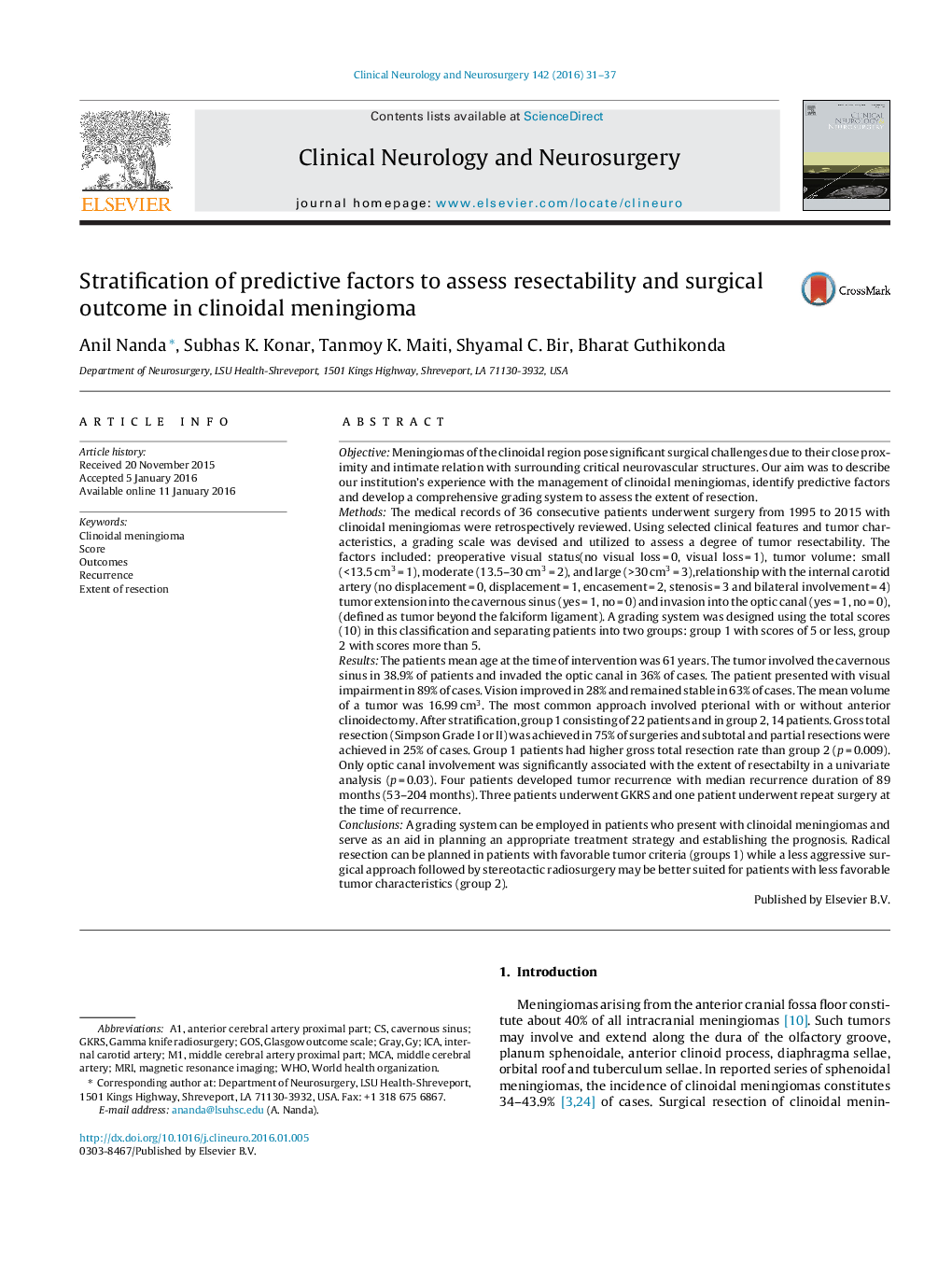| کد مقاله | کد نشریه | سال انتشار | مقاله انگلیسی | نسخه تمام متن |
|---|---|---|---|---|
| 3039549 | 1579680 | 2016 | 7 صفحه PDF | دانلود رایگان |
• Meningiomas of the clinoidal region pose significant surgical challenges.
• The grading system was developed to assess the resectability and long-term outcomes of clinoidal meningioma.
• Group 1 patients had higher gross total resection rate than group 2 (p = 0.009).
• Radical resection can be planned in groups 1 patients and safe surgery followed by radio surgery may be better for group 2 patients.
ObjectiveMeningiomas of the clinoidal region pose significant surgical challenges due to their close proximity and intimate relation with surrounding critical neurovascular structures. Our aim was to describe our institution’s experience with the management of clinoidal meningiomas, identify predictive factors and develop a comprehensive grading system to assess the extent of resection.MethodsThe medical records of 36 consecutive patients underwent surgery from 1995 to 2015 with clinoidal meningiomas were retrospectively reviewed. Using selected clinical features and tumor characteristics, a grading scale was devised and utilized to assess a degree of tumor resectability. The factors included: preoperative visual status(no visual loss = 0, visual loss = 1), tumor volume: small (<13.5 cm3 = 1), moderate (13.5–30 cm3 = 2), and large (>30 cm3 = 3),relationship with the internal carotid artery (no displacement = 0, displacement = 1, encasement = 2, stenosis = 3 and bilateral involvement = 4) tumor extension into the cavernous sinus (yes = 1, no = 0) and invasion into the optic canal (yes = 1, no = 0), (defined as tumor beyond the falciform ligament). A grading system was designed using the total scores (10) in this classification and separating patients into two groups: group 1 with scores of 5 or less, group 2 with scores more than 5.ResultsThe patients mean age at the time of intervention was 61 years. The tumor involved the cavernous sinus in 38.9% of patients and invaded the optic canal in 36% of cases. The patient presented with visual impairment in 89% of cases. Vision improved in 28% and remained stable in 63% of cases. The mean volume of a tumor was 16.99 cm3. The most common approach involved pterional with or without anterior clinoidectomy. After stratification, group 1 consisting of 22 patients and in group 2, 14 patients. Gross total resection (Simpson Grade I or II) was achieved in 75% of surgeries and subtotal and partial resections were achieved in 25% of cases. Group 1 patients had higher gross total resection rate than group 2 (p = 0.009). Only optic canal involvement was significantly associated with the extent of resectabilty in a univariate analysis (p = 0.03). Four patients developed tumor recurrence with median recurrence duration of 89 months (53–204 months). Three patients underwent GKRS and one patient underwent repeat surgery at the time of recurrence.ConclusionsA grading system can be employed in patients who present with clinoidal meningiomas and serve as an aid in planning an appropriate treatment strategy and establishing the prognosis. Radical resection can be planned in patients with favorable tumor criteria (groups 1) while a less aggressive surgical approach followed by stereotactic radiosurgery may be better suited for patients with less favorable tumor characteristics (group 2).
Journal: Clinical Neurology and Neurosurgery - Volume 142, March 2016, Pages 31–37
